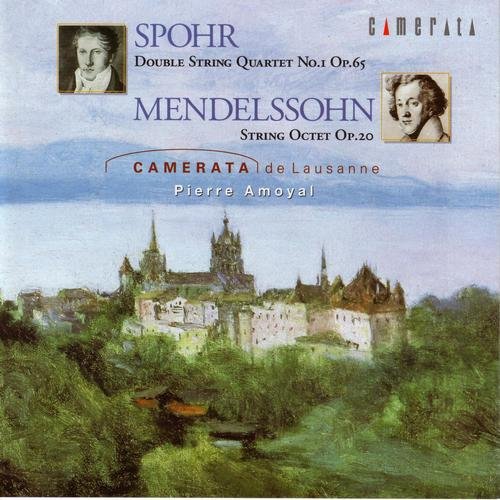Camerata de Lausanne, Pierre Amoyal - Spohr - Double String Quartet No. 1, Op. 65 / Mendelssohn - String Octet Op. 20 (2003)

Artist: Camerata de Lausanne, Pierre Amoyal
Title: Spohr - Double String Quartet No. 1, Op. 65 / Mendelssohn - String Octet Op. 20
Year Of Release: 2003
Label: Camerata
Genre: Classical
Quality: APE (image+.cue,log,scans)
Total Time: 56:45
Total Size: 270 Mb
WebSite: Album Preview
Tracklist: Title: Spohr - Double String Quartet No. 1, Op. 65 / Mendelssohn - String Octet Op. 20
Year Of Release: 2003
Label: Camerata
Genre: Classical
Quality: APE (image+.cue,log,scans)
Total Time: 56:45
Total Size: 270 Mb
WebSite: Album Preview
L. Spohr - Double String Quartet No. 1 in d, Op. 65
1. Allegro - 9:49
2. Scherzo: Vivace - 4:34
3. Larghetto - 2:51
4. Finale: Allegro molto - 6:17
F. Mendelssohn - String Octet in E-flat Major, Op. 20
5. Allegro moderato, ma con fuoco - 15:14
6. Andante - 6:39
7. Scherzo: Allegro leggierissiomo - 4:51
8. Presto - 6:07
Performers:
Camerata de Lausanne:
Violin: Pierre Amoyal, Marina Yakovleva, Felix Froschhammer, Yuko Shimizu
Viola: Yumi Kubo, Robin Lemmel (1-4), Kana Matsui (5-8)
Cello: Marie-Stephanie Janecek, Konstantin Evtimov
The two chamber works paired on this 2003 disc from Camerata, Louis Spohr's Double Quartet No. 1 in D minor, Op. 65 (1823), and Felix Mendelssohn's Octet in E flat major, Op. 20 (1825), are worth comparing for their similarities, but their contrasting features are more interesting to examine. Although both works were composed for four violins, two violas, and two cellos, Spohr divides this instrumental body into two antiphonal quartets, one highly active and virtuosic, the other purely accompanimental; Mendelssohn -- well aware of Spohr's novel approach -- interweaves eight more or less equal parts into a thoroughly developed, quasi-symphonic texture. Secondly, while both pieces were composed almost contemporaneously, and share the mellow, gemütlich style of music associated with the Biedermeier period, Spohr's work is obviously more experimental and anticipates the "age of the virtuoso" more than Mendelssohn's conservative work, which lacks flashiness and pursues instead a more balanced, serenely Classical course. The Camerate de Lausanne is both fiery and placid in these enjoyable works, though markedly different in interpretation, tone, and expression between the two performances. In the Double Quartet, the group is a little brash, and a bit messy in intonation; but in the Octet, it is much more attractive for its rounded ensemble blend and enthusiastic repartee. Camerata's reproduction is clear and quite resonant.
DOWNLOAD LINKS








